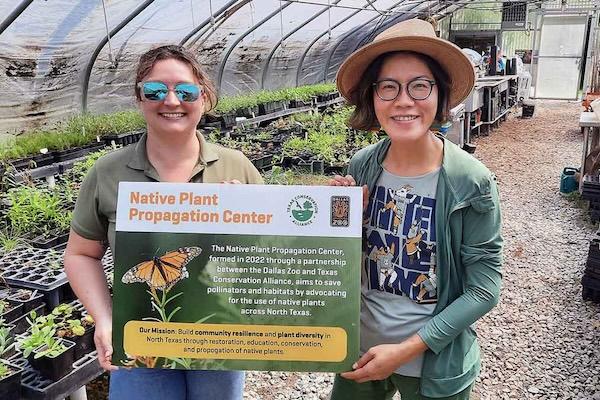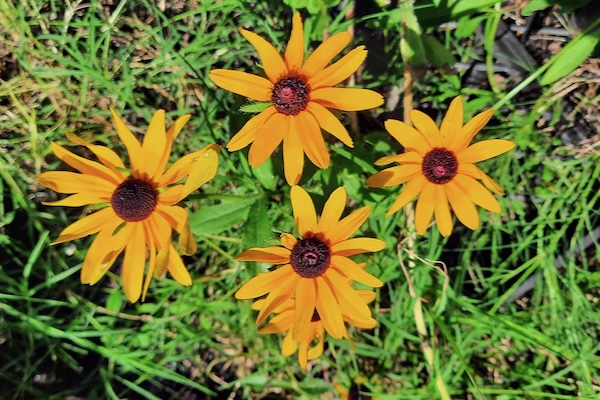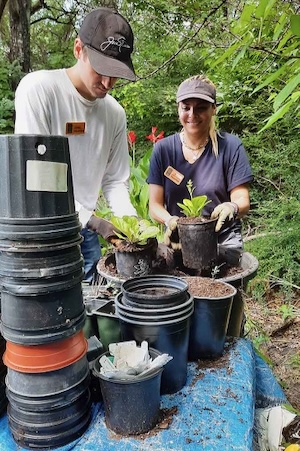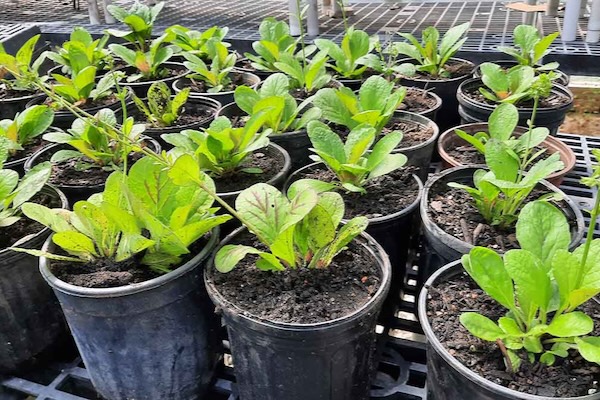
Katie Emmons of the Dallas Zoo and Mei Ling Liu of Texas Conservation Alliance celebrate the success of the native plant propagation center at the Dallas Zoo. Photo by Marshall Hinsley.
Tucked behind the bustling paths and exhibits of the Dallas Zoo is a quietly thriving project that’s restoring Texas’ native ecosystems one seedling at a time.
The Native Plant Propagation Center, launched in early 2022 through a partnership between Texas Conservation Alliance and the Dallas Zoo, is a growing hub for ecological restoration, public education, and grassroots biodiversity conservation.
The Center has propagated and distributed more than 30,000 native plants since its inception, providing critical habitat and food for Texas bees, butterflies and other wildlife. While the zoo maintains the growing space, TCA takes the lead in plant cultivation and community partnerships.
“Every year, we provide a thousand native plants to the zoo,” said TCA Community Conservation Director Mei Ling Liu. “They decide whether those plants go to restoration projects, educational events or even exhibits.”
The other 9,000 or so plants produced annually are used in community-based restoration projects, native plant giveaways and seasonal public plant sales — all tailored to promote native flora in urban and suburban landscapes.
BUILDING A NATIVE OASIS IN NORTH TEXAS
 The native plant propagation center at the Dallas Zoo has distributed more than 30,000 native plants since its inception. Photo by Marshall Hinsley.
The native plant propagation center at the Dallas Zoo has distributed more than 30,000 native plants since its inception. Photo by Marshall Hinsley.
Native plants, Liu explains, are critical to maintaining a natural balance and ecological services, particularly as development displaces native prairies, and pollinators struggle to survive in fragmented habitats. But sourcing these plants can be a challenge.
“When we started doing restoration in 2021, we realized how hard it was to find native plants — especially in the quantities we needed and at the right time of year,” Liu said. “So, we began growing our own.”
Today, the center grows around 110 native species, including rarities like whorled milkweed and Barbara’s buttons, as well as popular choices like Texas bluebells, American basketflower and partridge pea. Most are difficult to find in commercial nurseries.
Each year, native seeds are collected — often with help from volunteers or organizations like The Nature Conservancy — then propagated in the hoop house and greenhouse at the zoo. Most importantly, these plants are grown without pesticides, a practice Liu sees as non-negotiable.
“We want these plants to go right into the ground and start supporting pollinators. If we use chemicals like neonicotinoids, we’re defeating the whole purpose,” she said.
PARTNERSHIPS ROOTED IN COMMUNITY
 Volunteer native plant propagation coordinator Johana Franco prepares some plants for distribution. Photo by Marshall Hinsley.
Volunteer native plant propagation coordinator Johana Franco prepares some plants for distribution. Photo by Marshall Hinsley.
The center operates under a core principle: restoration must be collaborative. Through a plant match program, TCA partners with nonprofits and nature centers around North Texas — including Twelve Hills Nature Center, the Trinity River Audubon Center and others — to coordinate public planting events.
“In these programs, we donate two-thirds of the plants, and the partner organization contributes the rest,” Liu explained. “It becomes an event that brings people together to learn, plant and connect with nature.”
Cities and corporations can also participate in a variation of the plant match program. They receive one-third of the plants as a donation and must purchase the remaining two-thirds. This structure ensures viability for the TCA program while still promoting native plant use.
To date, the center has actively partnered with several North Texas cities including Cedar Hill, Lewisville, McKinney and Frisco, along with state organizations like the Texas Master Naturalists and the Native Plant Society of Texas to promote their programs and plants.
At the Dallas Zoo, many of the 3,000 plants they've received since 2022 are distributed at public events like Oak Cliff Earth Day and Juneteenth celebrations or are given away to visitors and staff. Some are planted into zoo landscapes and animal habitats.
“We’re trying really hard to integrate more native plants into the zoo’s landscaping,” said Katie Emmons, conservation programs coordinator at the Dallas Zoo. “We even give some to staff who are starting their own pocket prairies at home.”
MORE THAN A NURSERY: A LIVING CLASSROOM
The center is also as an educational resource. Every spring and fall, TCA hosts native plant sales that serve as both fundraisers and outreach efforts.
“It’s not just about selling plants,” said Liu. “It’s a chance to teach people about what grows well in their yards, what supports local insects, and why biodiversity matters.”
TCA also partners with programs like Trinity River Crew, a summer initiative by Trinity Park Conservancy and GreenSpace Dallas, which employs teens in hands-on environmental learning as they assist with plant propagation tasks.
“High school students come here, learn how we collect and process seeds, and help us build the infrastructure that keeps the center running,” said Liu. “It’s an opportunity to pass on conservation values to the next generation.”
SMALL SPACE, BIG IMPACT
The propagation center operates out of two horticultural structures on zoo grounds — a 30-by-50-foot greenhouse and a slightly smaller, shaded hoop house. While modest in size, the space is maximized through strategic planning and volunteer support.
“Our greenhouse was sitting empty after COVID because we restructured the way we handled on-grounds landscaping,” Emmons said. “So, when TCA approached us, it was a perfect fit.”
The two groups — with TCA managing propagation and the zoo providing essential resources and volunteer recruitment — have created a sustainable model of efficient, collaborative conservation.
And the work is far from done. The demand for native plants continues to grow, and Liu hopes that more people will embrace wildflower diversity not just as a trend, but as a cultural shift.
“We’re not just growing plants — we’re growing awareness,” Liu said. “Every plant in the ground is a step toward restoring what’s been lost.”
As urban development continues transforming North Texas landscapes, the Native Plant Propagation Center provides a resource for supporting ecological education and restoring wildlife habitat. Through careful cultivation of native species, strategic partnerships and public outreach, this center is nurturing both wildlife and the next generation of conservation advocates.
 Lyre leaf sage plants at the Dallas Zoo propagation center are ready to be distributed. Photo by Marshall Hinsley.
Lyre leaf sage plants at the Dallas Zoo propagation center are ready to be distributed. Photo by Marshall Hinsley.
HOW TO GET INVOLVED
Additionally, Liu says, the Native Plant Propagation Center welcomes public involvement through plant sales, volunteer days and educational outreach. Native seed donations are accepted from qualified collectors, and organizations can apply for participation in the plant match program for plant distribution.
For more information about upcoming plant sales or to inquire about collaboration, visit the Texas Conservation Alliance website or follow the Dallas Zoo’s conservation initiatives online.
